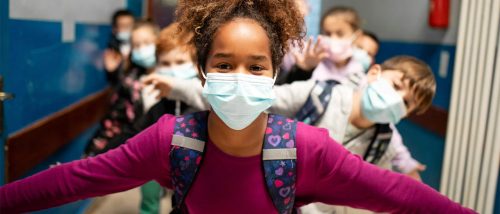Publication
How to safely maintain open schools during a pandemic is still controversial. We aim to identify those measures that effectively control the spread of SARS-CoV-2 in Austrian schools. By control we mean that each source case infects less than one other person on average. We use Austrian data on 616 clusters involving 2,822 student-cases and 676 teacher-cases to calibrate an agent-based epidemiological model in terms of cluster size and transmission risk depending on age and clinical presentation. Considering a situation in which the B1.617.2 (delta) virus strain is dominant and parts of the population are vaccinated, we quantify the impact of non-pharmaceutical intervention measures (NPIs) such as room ventilation, reduction of class size, wearing of masks during lessons, vaccinations, and school entry testing by SARS-CoV2-antigen tests.
In the tracing data we find that 40% of all clusters involved no more than two cases, and 3% of the clusters only had more than 20 cases. The younger the students, the more likely we found asymptomatic cases and teachers as the source case of the in-school transmissions. Based on this data, the model shows that different school types require different combinations of NPIs to achieve control of the infection spreading: If 80% of teachers and 50% of students are vaccinated, in primary schools, it is necessary to combine at least two of the above NPIs. In secondary schools, where contact networks of students and teachers become increasingly large and dense, a combination of at least three NPIs is needed.
A sensitivity analysis indicated that poorly executed mitigation measures might increase the cluster size by a factor of more than 17 for primary schools and even higher increases are to be expected for the other school types. Our results suggest that school-type-specific combinations of NPIs together with vaccinations are necessary to allow for a controlled opening of schools under sustained community transmission of the SARS-CoV-2 delta variant. However, large clusters might still occur on an infrequent, however, regular basis.
Jana Lasser, Johannes Sorger, Lukas Richter, Stefan Thurner, Peter Klimek, Assessing the impact of SARS-CoV-2 prevention measures in Austrian schools using agent-based simulations and cluster tracing data, Nature Communications 13 (554) (2022)
Related

Signup
| Cookie | Duration | Description |
|---|---|---|
| cookielawinfo-checkbox-analytics | 1 year | Set by the GDPR Cookie Consent plugin, this cookie records the user consent for the cookies in the "Analytics" category. |
| cookielawinfo-checkbox-functional | 1 year | The GDPR Cookie Consent plugin sets the cookie to record the user consent for the cookies in the category "Functional". |
| cookielawinfo-checkbox-necessary | 1 year | Set by the GDPR Cookie Consent plugin, this cookie records the user consent for the cookies in the "Necessary" category. |
| CookieLawInfoConsent | 1 year | CookieYes sets this cookie to record the default button state of the corresponding category and the status of CCPA. It works only in coordination with the primary cookie. |
| PHPSESSID | session | This cookie is native to PHP applications. The cookie stores and identifies a user's unique session ID to manage user sessions on the website. The cookie is a session cookie and will be deleted when all the browser windows are closed. |
| viewed_cookie_policy | 1 year | The GDPR Cookie Consent plugin sets the cookie to store whether or not the user has consented to use cookies. It does not store any personal data. |
| Cookie | Duration | Description |
|---|---|---|
| mec_cart | 1 month | Provides functionality for our ticket shop |
| VISITOR_INFO1_LIVE | 6 months | YouTube sets this cookie to measure bandwidth, determining whether the user gets the new or old player interface. |
| VISITOR_PRIVACY_METADATA | 6 months | YouTube sets this cookie to store the user's cookie consent state for the current domain. |
| YSC | session | Youtube sets this cookie to track the views of embedded videos on Youtube pages. |
| yt-remote-connected-devices | never | YouTube sets this cookie to store the user's video preferences using embedded YouTube videos. |
| yt-remote-device-id | never | YouTube sets this cookie to store the user's video preferences using embedded YouTube videos. |
| yt.innertube::nextId | never | YouTube sets this cookie to register a unique ID to store data on what videos from YouTube the user has seen. |
| yt.innertube::requests | never | YouTube sets this cookie to register a unique ID to store data on what videos from YouTube the user has seen. |
| Cookie | Duration | Description |
|---|---|---|
| _ga | 1 year | Google Analytics sets this cookie to calculate visitor, session and campaign data and track site usage for the site's analytics report. The cookie stores information anonymously and assigns a randomly generated number to recognise unique visitors. |
| _ga_* | 1 year | Google Analytics sets this cookie to store and count page views. |
| _gat_gtag_UA_* | 1 min | Google Analytics sets this cookie to store a unique user ID. |
| _gid | 1 day | Google Analytics sets this cookie to store information on how visitors use a website while also creating an analytics report of the website's performance. Some of the collected data includes the number of visitors, their source, and the pages they visit anonymously. |